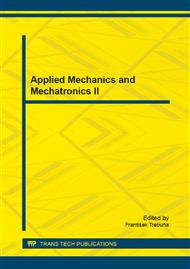[1]
M. Kelemen, Components and Modules of Mechatronic Systems (in Slovak). Faculty of Mechanical Engineering, Technical University of Košice, Košice 2004, ISBN 80-8073-212-4.
Google Scholar
[2]
T. Kelemenová, M. Kelemen, M. Dovica, Experimental Investigation of Actuator Elements Made of Shape Memory Materials (SMA) (in Slovak). Strojárstvo 5/2010, ISSN 1335-2938, <http: /www. strojarstvo. sk>.
Google Scholar
[3]
E. M. Severinghaus, Low Current Shape Memory Alloy Devices. U. S. Patent US6969920B1, Nov. 29, 2005. Monomotronics.
Google Scholar
[4]
O. Ostertag et al, Miniature Mobile In-pipe Machine. In: International Journal of Advanced Robotic Systems. Vol. 11 (2014), pp.1-9. ISSN 1729-8806.
Google Scholar
[5]
Dynalloy Inc., Flexinol Technical Characteristics (online). Document version 2011/01/02 T15: 31: 00Z 2011 <http: /www. dynalloy. com>.
Google Scholar
[6]
S. Kajiwara, Characteristic Features of Shape Memory Effect and Related Transformation Behaviour in Fe-based Alloys. Mater. Sic. Eng., A 273-275 (1999) 67-88.
DOI: 10.1016/s0921-5093(99)00290-7
Google Scholar
[7]
H. Funakubo, Precision Machinery and Robotics, Vol. 1-Shape Memory Alloys. Gordon and Breach, (1987).
Google Scholar


